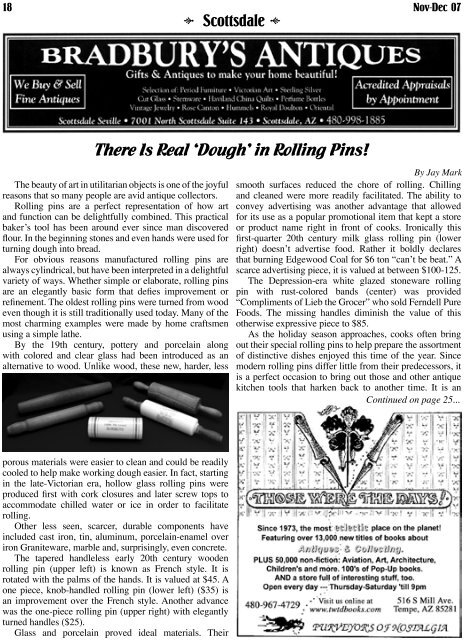The Antique Register
The Antique Register
The Antique Register
Create successful ePaper yourself
Turn your PDF publications into a flip-book with our unique Google optimized e-Paper software.
18 Nov-Dec 07<br />
� Scottsdale �<br />
<strong>The</strong>re Is Real ‘Dough’ in Rolling Pins!<br />
<strong>The</strong> beauty of art in utilitarian objects is one of the joyful<br />
reasons that so many people are avid antique collectors.<br />
Rolling pins are a perfect representation of how art<br />
and function can be delightfully combined. This practical<br />
baker’s tool has been around ever since man discovered<br />
flour. In the beginning stones and even hands were used for<br />
turning dough into bread.<br />
For obvious reasons manufactured rolling pins are<br />
always cylindrical, but have been interpreted in a delightful<br />
variety of ways. Whether simple or elaborate, rolling pins<br />
are an elegantly basic form that defies improvement or<br />
refinement. <strong>The</strong> oldest rolling pins were turned from wood<br />
even though it is still traditionally used today. Many of the<br />
most charming examples were made by home craftsmen<br />
using a simple lathe.<br />
By the 19th century, pottery and porcelain along<br />
with colored and clear glass had been introduced as an<br />
alternative to wood. Unlike wood, these new, harder, less<br />
porous materials were easier to clean and could be readily<br />
cooled to help make working dough easier. In fact, starting<br />
in the late-Victorian era, hollow glass rolling pins were<br />
produced first with cork closures and later screw tops to<br />
accommodate chilled water or ice in order to facilitate<br />
rolling.<br />
Other less seen, scarcer, durable components have<br />
included cast iron, tin, aluminum, porcelain-enamel over<br />
iron Graniteware, marble and, surprisingly, even concrete.<br />
<strong>The</strong> tapered handleless early 20th century wooden<br />
rolling pin (upper left) is known as French style. It is<br />
rotated with the palms of the hands. It is valued at $45. A<br />
one piece, knob-handled rolling pin (lower left) ($35) is<br />
an improvement over the French style. Another advance<br />
was the one-piece rolling pin (upper right) with elegantly<br />
turned handles ($25).<br />
Glass and porcelain proved ideal materials. <strong>The</strong>ir<br />
By Jay Mark<br />
smooth surfaces reduced the chore of rolling. Chilling<br />
and cleaned were more readily facilitated. <strong>The</strong> ability to<br />
convey advertising was another advantage that allowed<br />
for its use as a popular promotional item that kept a store<br />
or product name right in front of cooks. Ironically this<br />
first-quarter 20th century milk glass rolling pin (lower<br />
right) doesn’t advertise food. Rather it boldly declares<br />
that burning Edgewood Coal for $6 ton “can’t be beat.” A<br />
scarce advertising piece, it is valued at between $100-125.<br />
<strong>The</strong> Depression-era white glazed stoneware rolling<br />
pin with rust-colored bands (center) was provided<br />
“Compliments of Lieb the Grocer” who sold Ferndell Pure<br />
Foods. <strong>The</strong> missing handles diminish the value of this<br />
otherwise expressive piece to $85.<br />
As the holiday season approaches, cooks often bring<br />
out their special rolling pins to help prepare the assortment<br />
of distinctive dishes enjoyed this time of the year. Since<br />
modern rolling pins differ little from their predecessors, it<br />
is a perfect occasion to bring out those and other antique<br />
kitchen tools that harken back to another time. It is an<br />
Continued on page 25...



